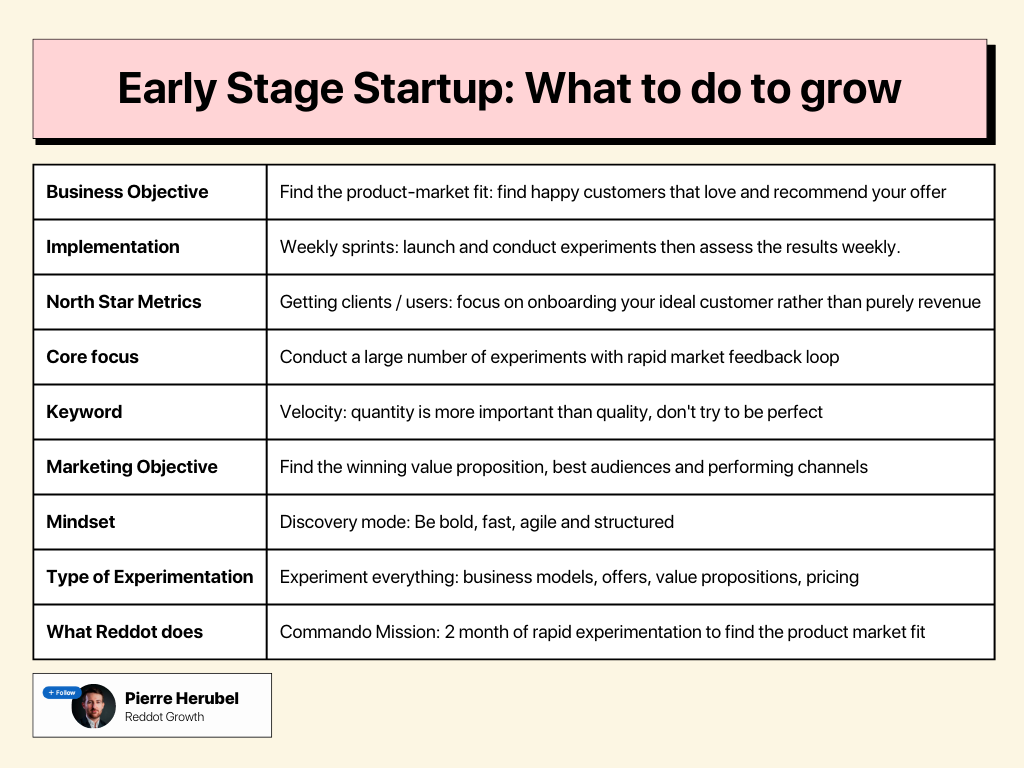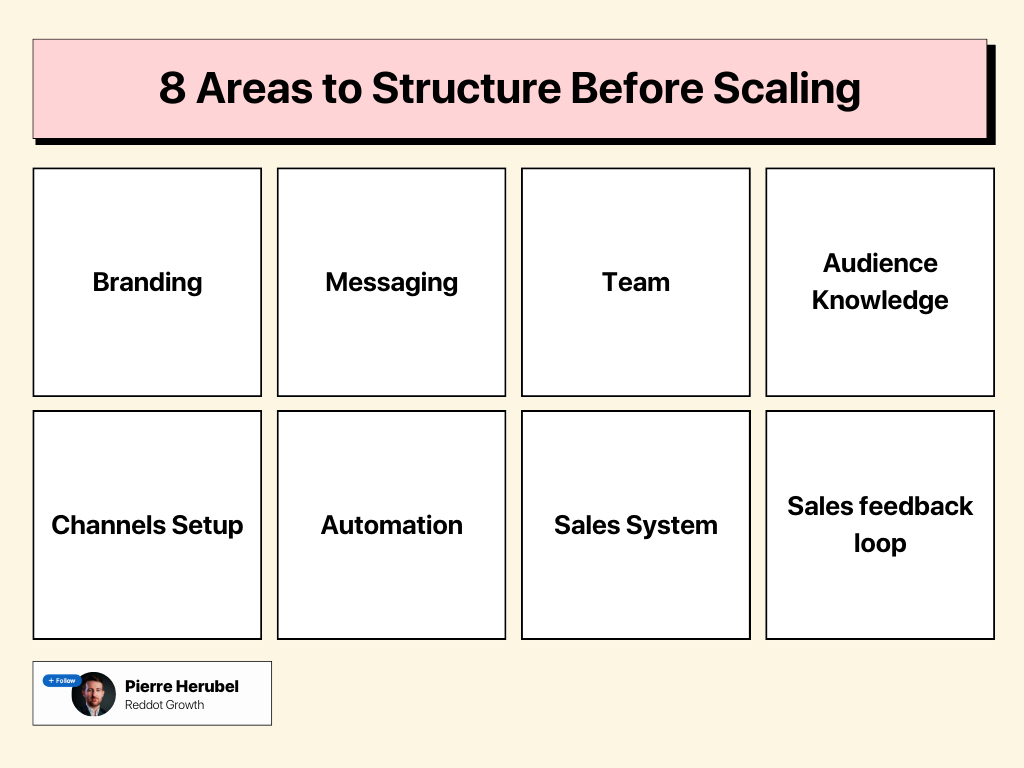👋 Hello and welcome to the 6th edition:
“The 3 Stages of Growth Marketing for Startups”
Startups are born, they grow and then thrive.
Of course, many of them die, but today I will focus on a positive scenario.
After analyzing hundreds of early-stage startup’s growth strategies, I’ve identified patterns. The growth of a startup can be divided into 3 distinct phases:
Early stage 🔵
Consolidation stage 🟢
Growth stage 🔴
Those stages need to be adapted to each situation as marketing is subtle (even if social media makes you think everything is binary). But I am confident those 3 concepts will help you build your Marketing Strategy.
In this edition, I am going to answer 4 questions:
What are the 3 stages of growth of a startup?
How can you know which stage you are in?
What channels and tactics should be used depending on the stage?
What should be the main objectives depending on the stage?
1. Early stage 🔵 The Reign of Velocity
Here’s a quick story:
Jerry Uelsmann, a professor at the University of Florida, decided to run an experiment on his class of film photography students.
He divided his class into two groups:
Quantity Group vs Quality Group
The quantity group had to produce a large number of photos and were graded based on quantity.
The quality group aimed for one perfect photo, graded on excellence.
At the end of the experiment, the quantity group produced the best photos because they experimented, learned from their mistakes, and honed their skills through practice. The quality group focused on perfection but ended up with only theories and a standard photo.
This phenomenon can be applied to every skill and area. Especially in new businesses.
It teaches us 5 lessons:
Aiming for perfection is dangerous
It’s easier to get better with a lot of attempts
Trials and errors are the fastest route to success
Failed experiments reduce the risk of long-term failure
You should start with repetition, not pressure from goals
Overall, true learning and progression come from a lot of micro-experiments.
That’s why the keyword of the early stage is velocity.
Velocity is the speed and the direction of motion of an object.
Founders and marketers from an early-stage business must embrace velocity and go into “discovery mode”.
Like a scientist, they should:
Have 0 assumptions about their market and audience
Ideate and conduct as many experiments as possible
Be close to their subject: talk with their audience
Here's what you should do:
In this phase you should focus on channels and tactics that bring 2 kind of outputs:
Quick feedback loop: You get learnings very fast about your offer and the offer-channel fit (within 2 weeks)
Quick results: You know quickly if the results are good, bad, or if you need to pivot something in your offer
The feedback loop is more important than the results at the beginning. Because over time, learnings will compound and become a real asset for your growth.
So I recommend you to look at channels and tactics that bring fast market feedback:
Cold emailing (free guide here 📕)
Social selling on Linkedin
Account-based marketing (outbound)
Social and search ads
Direct sell during industry events
Interviewing customers and prospects
After weeks or months of experimentation, you’ll eventually find the 3-part formula to get happy customers:
Audience x Channel x Message
Audience: Who loves your offer?
Channel: Where do you find them?
Message: What convinces them?
Examples:
Founders x Linkedin x Save time on invoicing
Elders x Facebook x Prepare your retirement
Students x Tiktok x Get accepted in the best schools
Note that you can find several combinations like those.
But finding only 1 combination is already enough to generate $1-2M of revenue per year (or even more).
Once you have found the answer to this formula and discovered your product market fit, you can go into the consolidation stage.
2. Consolidation Stage 🟢 Structuring the Kingdom
Once you find product-market fit, your day-to-day becomes totally different:
More demands to address
More clients to onboard
More revenue to manage
More questions to answer
More problems to solve
Overall more of everything
Now the good news is that you’ll have more revenue.
At this stage, it can be tempting to accelerate directly to generate more cash.
(It’s really tempting, trust me.)
But I recommend going through a consolidation phase first.
What does it mean to “consolidate”? 🤔
In simple terms: prepare for the growth to make sure your startup doesn’t break.
The goal of consolidation is to create greater efficiency, clarity, and robustness.
If we are talking about growth marketing only, here are a few components that should be structured before scaling:
Team structure and roles
Acquisition system
North star metrics
Messaging strategy
Audience knowledge
Dos and don’ts of the brand
Customer acquisition cost target
This list is not exhaustive.
To structure these components, you should carry out a series of tasks:
Set up your marketing automation to save time on repetitive tasks
Prepare and share with the team the company’s branding rules
Consolidate your audience knowledge with market research
Run workshops to align everyone on the marketing strategy
Create a series of SOPs for standard marketing procedures
Perfect the client onboarding and delivery process
Organize your weekly backlogs to track progress
Install a flow of weekly and monthly meetings
This list is not exhaustive.
Here’s a table of the 8 mandatory areas to structure:
🧠 Don’t get me wrong:
You should keep growing during the consolidation stage. You should do both at the same time. The point is to not accelerate too fast. Otherwise your marketing and operations system could break.
After consolidating your marketing system, you should be ready to go into “growth mode”.
3. Growth Stage 🔴 Build the Empire
If we recap, here is the perfect scenario:
You launch a startup → You run a lot of experiments → You find the product market fit after 8 months → You consolidate your growth system → You are ready to scale.
Once structured you can seamlessly go into an acceleration phase that I call the “growth stage”.
Your objective is now to scale revenue, which includes 5 key pillars:
Reaching your target audience
Creating demand among passive buyers
Turning active buyers into revenue pipeline
Converting prospects into deals
Retaining clients
While doing this, you should keep brand consistency across channels.
Here’s how to do it:
In my opinion, the marketing game is totally different here. Velocity is still important but the keyword is consistency.
Your goal is now to find long-term revenue streams for your growth.
These money streams need to be:
Consistent: Revenue can vary across months because of seasonalities, but the stream should always be around the same level.
Predictable: You need to be able to predict revenue based on a customer acquisition cost + lifetime value + annual recurring revenue so your CFO loves you.
Motivation-proof: The less dependent on founders or C-Level motivation, the better it is. Because motivation comes and goes.
→ For this, you need to develop “marketing programs”.
Let me explain:
First, what is a marketing program?
It’s a long-term activity that generates revenue for your business.
Examples:
An outbound system
An industry podcast
A nurturing program
A slack community
A weekly webinar
Linkedin content
A content hub
A newsletter
→ Each of these programs can generate revenue of at least $1-2 million per year.
Marketing programs are different from experiments.
But you should run both at the same time.
Why you should run experiments AND programs at the same time?
You need to validate the viability of a program with experimentation before actually investing in it.
Example:
You should run 5 cold email campaigns across 3 industries before actually investing $100K into an outbound system. You should make sure of 3 things:
The return on investment is good (or promising)
The tactic can scale, it’s replicable
The tactic doesn’t damage your brand
We can sum up the idea with this simple process:
Experiment → Assess viability and repeatability → Create a marketing program
Here’s an example:
Test outbound campaign → Test at a bigger scale → Invest $100K in an outbound system
Here is a visual representation of the process:
At this stage, a good practice is to break down your marketing programs into 2 types:
Demand Creation: programs that build awareness, authority and foster demand among buyers. This could be a content strategy, personal brands, social media posts, video shorts, or a podcast.
Demand Capture: programs that turn active buyers into revenue pipeline. This could be an ABM system, LinkedIn ads, a content hub, a lead magnet, or a sales system.
I will write a full article on how to create marketing programs but to keep you waiting, have a look at this Linkedin carrousel: 6-step process to learn how to develop a marketing program.
Thank you for reading this edition.
If you enjoyed it, feel free to share it with your connections.
👉 If it’s not already the case you can:
Follow me on Linkedin for daily marketing tips
Follow me on Twitter for growth and build in public
Execute your growth strategy with me and my team
Book a 60-min power-hour call with me for marketing advisory
Contact me directly by email or DM for a 30-day Strategy sprint at pierre@reddotgrowth.com












It's really helpful to have a clear view of the different phases and processes. Thanks for sharing Pierre!
Really good edition 👍 Love the principle of having marketing programs, which is for me the basis of a scalable growth engine, along with continuing experimenting to find new tactics and revenue pockets